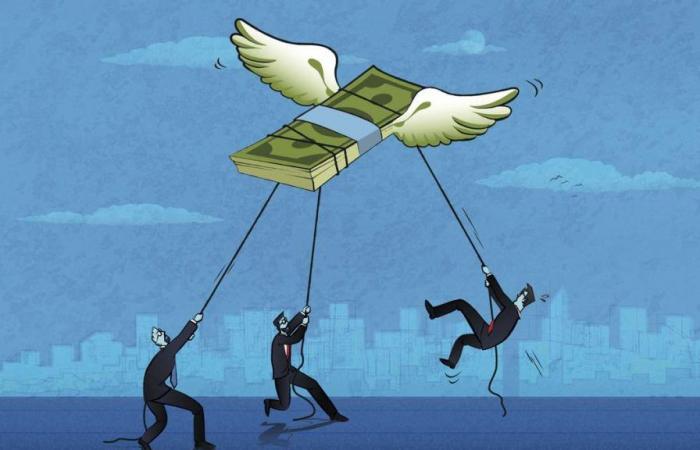Exchange rates are sensitive to international news: changes in government, monetary policy decisions, reform announcements, international conflicts, the price of oil, large stock movements, among others. Reference image.
Photo: Getty Images
Currently, the exchange rate between the US dollar and the Colombian peso is at the highest point so far in 2024. After the close of last Friday, June 14, the greenback is trading at $4,151, a figure that has not been seen since October of last year.
One of the most striking aspects was the rapid rebound of the currency in a matter of a few days: from June 11 to 14, the price of the dollar increased by $207.
For experts in exchange issues, the dollar is responding to events (national and international) that generate uncertainty in the financial markets, that is, where currency exchanges are carried out.
This inflow and outflow of foreign currency defines a good part of the difference between the dollar and the Colombian peso.
What are the factors behind the dollar’s rally? Could the increases become a trend? When could the exchange rate go down? We tell you.
The crest of the dollar
Before the rebound at the end of the week, the exchange rate had been oscillating between $3,900 and $4,000. In April, the price of the currency even registered a dip that briefly left it below $3,800, fortunately for those who make international purchases or took a trip abroad.
In recent days, the dollar reached highs of $4,215. What factors are behind the crest of the wave in which the dollar is located? The answer could be north of the continent. More precisely, in the United States economy.
Last Wednesday, the United States Federal Reserve (Fed) decided to keep its interest rates stable (between 5.25% and 5.5%), meeting expectations. However, Fed officials anticipated only one rate cut for the remainder of the year, two less than predicted at the beginning of the year.
The recent devaluation of the Colombian peso against the dollar is related to the recent decision of the Fed, as explained Sebastian Chacon Marindirector of the School of Business and International Development of the Grancolombiano Polytechnic.
You might be interested in: In July the working day will be reduced: who will not have the benefit?
“Although inflation in the United States has decreased (3.3% in May), it is still considered high. Although a reduction of 0.75 points in interest rates was predicted, this will now only be 0.25 points in 2024. In addition, the decrease in consumer confidence in the United States does not allow us to foresee improvements in interest rates in the short term,” explains Chacón.
Meanwhile, exchange rates are sensitive to international news: changes in government, monetary policy decisions, reform announcements, international conflicts, the price of oil, large stock movements, among others.
Precisely, international exchange markets, particularly those in Latin America, have been reacting negatively to the change of Government in Mexico for several days.
“After that (the elections in Mexico), the exchange rate in Colombia has depreciated a little more than 5% (…),” he points out. Jackeline Pirajáneconomist at Scotiabank Colpatria.
The Colombian panorama
For Michael Ortegondean of the Faculty of Economic and Administrative Sciences of UNINPAHU, Ecopetrol’s crude oil reserves are another aspect that is shaping an upward trend in the dollar.
“The capacity of oil reserves, with a closing of 2023 at 1,883 million barrels for Ecopetrol, can impact the supply and demand of foreign currency; “a robust capacity can stabilize the exchange rate, while a limited capacity could exert upward pressure,” the expert asserts.
You might be interested in: MinTransporte made a call to get money for construction projects
On the other hand, Henry Amorochoprofessor of Public Finance at the Universidad del Rosario, considers that the announcements of the Medium-Term Fiscal Framework will analyze investors who think about taking their dollars to Colombia.
“The saving or postponement of spending announced by the Ministry of Finance, which would be $20 billion, is an action that corrects that mistake on which the 2023 Fiscal Framework was based: a growth of the Colombian economy of 1.2% that It was really 0.6% last year,” he points out.
A high dollar the rest of the year?
Although the dollar had a quick response to the international and national events of recent days, analysts agree that the dollar would spend between $4,000 and $4,100 in the second half of the year.
Sebastián Chacón agrees with the above, for whom the dollar could end the year around $4,100.
“Given this sense of regional uncertainty, we believe that part of the movement of the dollar is structural, that is, we are not expecting the dollar to drop significantly again in the short term,” predicts the Scotiabank Colpatria economist.
And he adds: “it is likely that households will have to adjust their budgets a little for (international) travel, but we do not believe that it is a situation that will definitively bring down international tourism.”
You might be interested in: The doubts after the approval of the pension reform of the Petro Government
Another point to highlight is that companies producing goods and services usually make their input purchases when there is a low dollar, so it is not likely that in the short term households will feel the effect of this depreciation of the Colombian peso.
In addition to the echoes of the elections in Mexico, experts in exchange issues will be attentive to other fiscal announcements from the Colombian Government, international conflicts (such as in the Middle East or Ukraine) and the following decisions by the US regulator.






